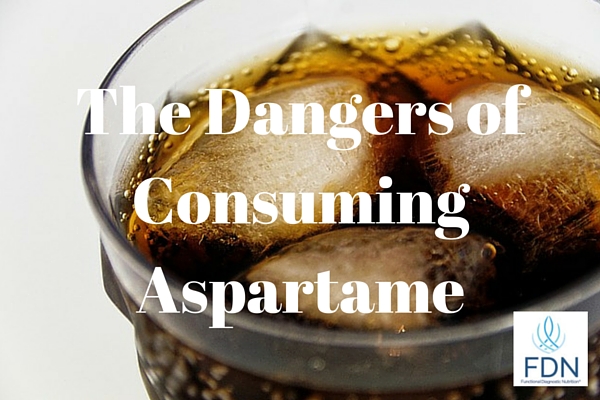Aspartame, more commonly known as the brand names NutraSweet or Equal, is an artificial sweetener that’s commonly found in many diet sodas and other low calorie products. Aspartame is a dangerous substance that should have never been approved, and because of the modern obsession with restricting calories, millions of people are risking their health by consuming the many products that contain it.
Aspartame has been reported to have upwards of 100 side effects, many of which are neurological or related to impaired nervous system function. Aspartame usage has even been associated with the diagnosis of serious conditions such as multiple sclerosis, fibromyalgia, lupus, brain tumors, and even death. Under the NutraSweet label, aspartame is sold in more than 100 countries, is found in more than 6,000 products, and is consumed by more than 250 million people including more than two thirds of the American population. The fact that aspartame has significantly compromised the lives of many people is very real and its use is a serious risk that lacks any reasonable justification whatsoever, especially when natural alternatives exist that are much safer.
The Dark History of Aspartame’s Approval
In 1965, a scientist for G. D. Searle & Company was developing a drug for the treatment of ulcers and accidentally spilled the substance he was working with on his hand. After instinctively licking it off and noticing a sweet taste, aspartame was born.
In 1970, G. D. Searle conducted one of their first studies on aspartame by feeding it to monkeys for 52 weeks. Of the 7 monkeys fed aspartame, 1 died and 5 suffered grand mal seizures. In the same year, neuroscientist Dr. John Olney discovered through research of his own that one of the main ingredients of aspartame caused brain tumors in mice. Despite the results of their monkey study, and despite replicating the results of Dr. Olney’s work, G. D. Searle forged ahead and submitted an application to the FDA in 1973 for the approval aspartame as a food additive.
After requesting additional information from G. D. Searle, the FDA granted preliminary approval of aspartame in 1974 but would not allow it to be marketed. Based on some serious questions that had arisen from G. D. Searle’s suspect research, the FDA formed a task force to closely examine the studies that aspartame’s preliminary approval was based on. The result of this was the “Bressler report” which identified a number of significant flaws in G. D. Searle’s research including delays of sometimes more than a year before research animals were autopsied, animals with tumors being reported as normal, and failing to report other issues such as enlarged lymph nodes and testicular atrophy.
In 1977, the FDA requested a criminal investigation of G. D. Searle’s alleged deletion, manipulation, and falsification of records regarding the testing of aspartame and other products. Before the investigation could be completed, Samuel Skinner, the U.S. attorney assigned to this investigation, resigned and accepted a job with G. D. Searle’s law firm Sidley & Austin. William Conlin, who was Skinner’s former assistant, took over the investigation and let its statute of limitations expire. Aspartame was saved by the bell, and afterward, Conlin accepted a job with G. D. Searle’s law firm as well.
Politics at Its Finest
As G. D. Searle was falling apart due to the controversies surrounding aspartame, Donald Rumsfeld, the former U. S. Secretary of State, was hired in 1977 to run the company and push for aspartame’s approval. Despite a request from the Food Safety Council to collaborate with G. D. Searle and conduct additional research on the safety of aspartame, Rumsfeld eventually declined and chose to pursue its approval without conclusive safety data. Meanwhile, the FDA had established a Public Board of Inquiry to evaluate the safety of aspartame and voted unanimously to not approve it until research was done to further evaluate its association with brain tumors.
The day after Ronald Regan was sworn into office as President, with Donald Rumsfeld as a member of his transition team, he suspended the authority of the FDA commissioner and replaced him a month later with Dr. Arthur Hull Hayes. During this time, G. D. Searle reapplied for the approval of aspartame and submitted new supporting research. Three of the five FDA scientists responsible for evaluating the evidence relating to brain tumors advised against aspartame’s approval. Dr. Hayes, the newly appointed FDA commissioner, appointed a new member to this panel to establish a tied vote and proceeded to overrule the FDA’s Public Board of Inquiry and approve aspartame for use in dry foods. Two years later, aspartame was also approved for use in carbonated beverages and Dr. Hayes left the FDA to work for G. D. Searl’s public relations firm at the rate of $1,000 per day.
According to the Delaney clause of the Food, Drug, and Cosmetic Act, no additive should be regarded as safe if it’s been shown to induce cancer. Based on this, aspartame should have never been approved. However, the deceptive manipulations behind the approval of aspartame spread overseas where G. D. Searle, still under the direction of Rumsfeld, was able to facilitate the highly controversial approval of aspartame in England. From this point, the approval and use of aspartame spread throughout the world.
The Dangers of Consuming Aspartame
When aspartame was fully approved in 1983, the American population as a whole began consuming it in massive amounts. By 1984, roughly 7 million pounds of it were being consumed. In the next year, this figure doubled and continued to grow steadily into the 1990s. Within 6 months of the release of aspartame, the rate of brain tumors increased by 10%, diabetes increased by 30%, and brain lymphoma increased by 60%. By 1988, over 80% of voluntary complaints filed to FDA were related to aspartame. By 1992, the FDA had received more than 10,000 complaints of aspartame reactions, and through their own admittance, less than 1% of people who experience a reaction to a product actually report it.
Aspartame consists of methyl ether and the amino acids phenylalanine and aspartic acid. When ingested, the methyl ether in aspartame becomes highly toxic methyl alcohol which is also known as methanol or wood alcohol and can be lethal in doses as small as four ounces. The methanol from aspartame is broken down into formaldehyde which is dangerous toxin that the body is unable to eliminate. Although the amount of methanol and formaldehyde produced from aspartame is small, the effects can easily accumulate over time and cause serious problems including fatal kidney damage, blindness, organ failure, and even death. Formaldehyde is also believed to cause cancer and is known to alter DNA.
A Deceptive Interpretation of Nature
Proponents of aspartame point out that common foods such as fruits contain much more methanol. However, the methanol in fruit is bound to a type of fiber called pectin which prevents the molecule from being digested by humans and allows it to easily pass through the body without being absorbed. Furthermore, even if the methanol in fruit were to be separated from the pectin, it would likely be counteracted by the ethanol that fruit also contains. This is not the case with aspartame.
Although phenylalanine and aspartic acid are amino acids that naturally exist in food, in such cases, they’re balanced with other amino acids. In contrast, when phenylalanine and aspartic acid are consumed in their free forms as part of aspartame, they exist in unnaturally high concentrations. According to neurosurgeon Dr. Russel Blaylock, in such concentrations, aspartic acid acts as an excitotoxin that can kill brain cells by overstimulating them, and phenylalanine is a neurotoxin that can cause seizures and nervous system dysfunction. This is why many of the symptoms associated with aspartame consumption are related to dysfunction of the brain and nervous system.
The damaging effects that aspartic acid can have on the brain are believed to contribute to neurodegenerative diseases such as Alzheimer’s and Parkinson’s and have been shown to promote the production of free radicals which are implicated in a number diseases including heart disease, cancer, and arthritis.
As a precursor to norepinepherine, phenylalanine can also alter the balance of important brain neurotransmitters, especially serotonin, and increase the likeliness of mood issues, panic, and seizures as a result. Because of this, aspartame is also addictive. In addition, phenylalanine can decompose into the known carcinogen diketopierazine (DKP) when exposed to warm temperatures. This is a significant concern for the aspartame products that are transported in hot weather or stored in hot warehouses.
The Other Side of the Aspartame Argument
In my opinion, you’d have to be out of your mind to consume aspartame after being made aware of its risks. However, everyone is entitled to their own opinions and some people consider aspartame to be safe. Early in aspartame’s tainted history, representatives of G. D. Searle and even some from the FDA proclaimed aspartame to be safe based on it being the most tested food additive ever, but this is misleading considering the poor quality of the supporting research.
We clearly know that G. D. Searle had a vested interest in aspartame and that their research is highly questionable. We also know that the FDA can be very biased. Ralph Walton MD conducted a peer review of 166 aspartame studies conducted between 1970 and 1998 that were related to human safety. 74 of these studies had funding sources that were tied to aspartame, and the remaining 92 were funded by independent sources. All of the industry funded research concluded that aspartame is safe, and in nearly complete contrast, 92% of the independently funded studies found at least one problem suggesting otherwise.
In 1985, G. D. Searle was acquired by Monsanto which is another chemical manufacturer that also has a tainted history of corruption. Monsanto has been under tremendous scrutiny because of their involvement with the now outlawed chemicals DDT and PCBs, and most recently, genetically modified foods. After acquiring G. D. Searle, Monsanto established the NutraSweet company to handle its aspartame operations and claimed that they’d support new research on aspartame by providing free samples to legitimate researchers. However, when Dr. Walton requested samples for a double blind study on the safety of aspartame, his request was refused and he was told that his research was unnecessary. The NutraSweet company even refused to sell him aspartame.
When Dr. Walton finally obtained samples from another source and conducted his study, two of his subjects experienced internal eye bleeding, one of which also suffered a detached retina and ultimately lost vision in the same eye. This is in addition to a number of other unpleasant but less severe adverse reactions experienced by the remaining participants.
Is Government Betraying Us?
Despite the FDA’s mixed actions throughout the approval of aspartame, the government hasn’t been completely innocent either. Former FDA Investigator Arthur Evangelista confirms this by indicating that the FDA approved aspartame despite investigators knowing that the supporting evidence for its safety was inadequate. The FDA has also made it difficult to obtain the Bressler report referenced earlier despite the existence of the Freedom of Information Act, and according to people who have spoken directly with Jerome Bressler, the FDA has even deleted 20% of its content including a signature from a high level official.
In 1986, based on only about 600 of the more than 10,000 aspartame reactions reported to the FDA, the U.S. Centers for Disease Control (CDC) created a 146 page report assessing its potential to cause cardiac arrest, seizures, liver problems, mood alteration, and even death. Not surprisingly, this report isn’t available on the CDC’s website, and the summary of the report that is available seems to be an attempt to soften the perceived severity of the risks associated with aspartame. If the majority of aspartame reactions are as mild as the CDC claims in their summary, then what reason do they have to hide this report from us?
Despite the controversy surrounding aspartame, its use has also been supported by prestigious and influential organizations including the American Dietetic Association, the American Diabetes Association, and the American Medical Association. Apparently, monetary influence may be even more of a risk to our health than aspartame. Adding insult to injury, the people who get sick from substances like aspartame are often prescribed medications that are manufactured by the same drug companies that made them sick in the first place. This vicious cycle is great for the drug industry and our government is helping to facilitate it.
Still Not Convinced?
As I previously mentioned, everyone is entitled to their own opinions. Mine is that you’d have to be crazy to consume aspartame. Regardless of how unlikely the major reactions to aspartame may be, there’s really no need for artificial sweeteners, and in turn, no reason to risk your health by using them. Besides, even if you’re not experiencing any major reactions from aspartame, this doesn’t mean its effects aren’t accumulating within your body and won’t cause serious problems later in life. Finally, with the availability of natural sweeteners like stevia, there’s really no reason to use an artificial sweetener like aspartame, Splenda, or any other. In my opinion, anyone who perceives the need to use sweeteners on a regular basis, whether natural or not, is neglecting the most important principle of healthy eating which is eating whole, real foods.
For more information, I highly recommend that you watch the Sweet Misery documentary. If the interviews with the experts who’ve extensively researched aspartame and the individuals who’ve suffered greatly from consuming it don’t make you furious about how badly we’ve been misled, they should at least make you reconsider consuming aspartame yourself. You can also read the book Sweet Deception by Dr. Joseph Mercola which provides great information on Splenda and other sweeteners as well.








